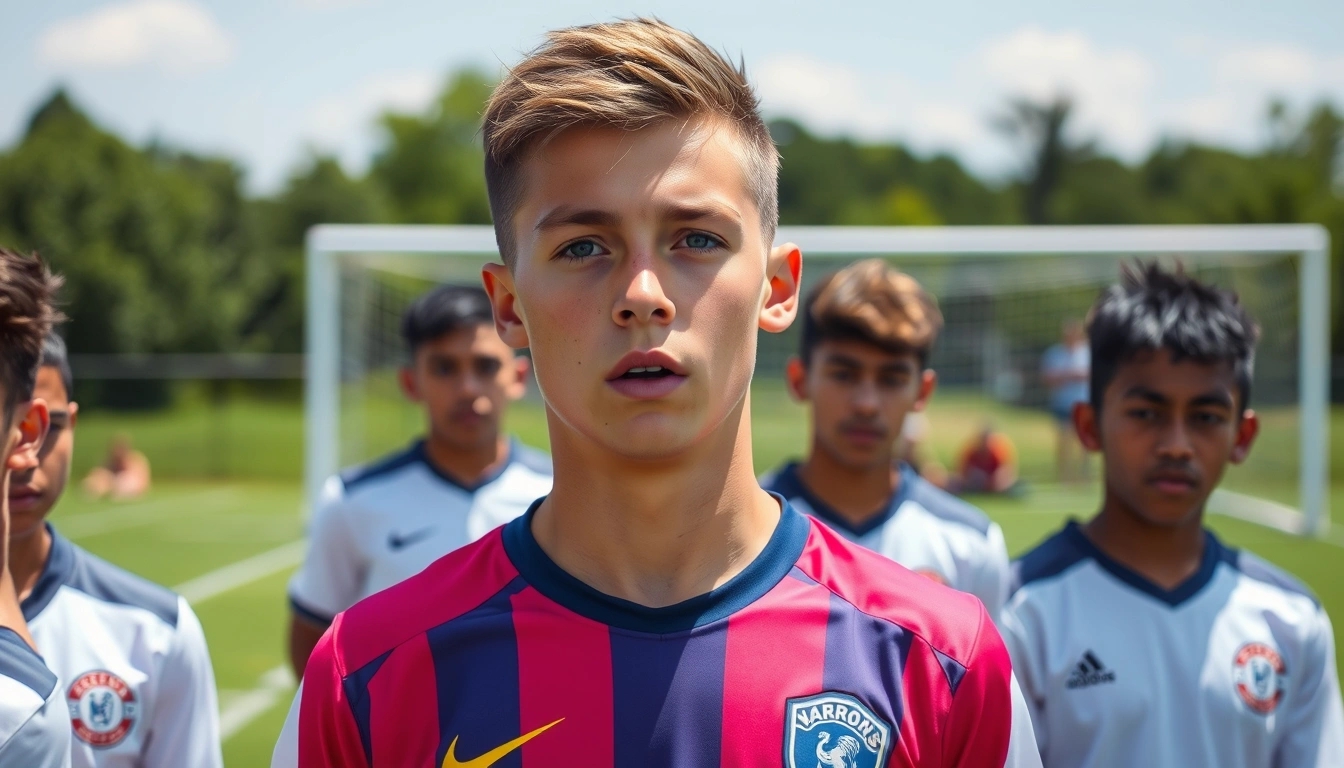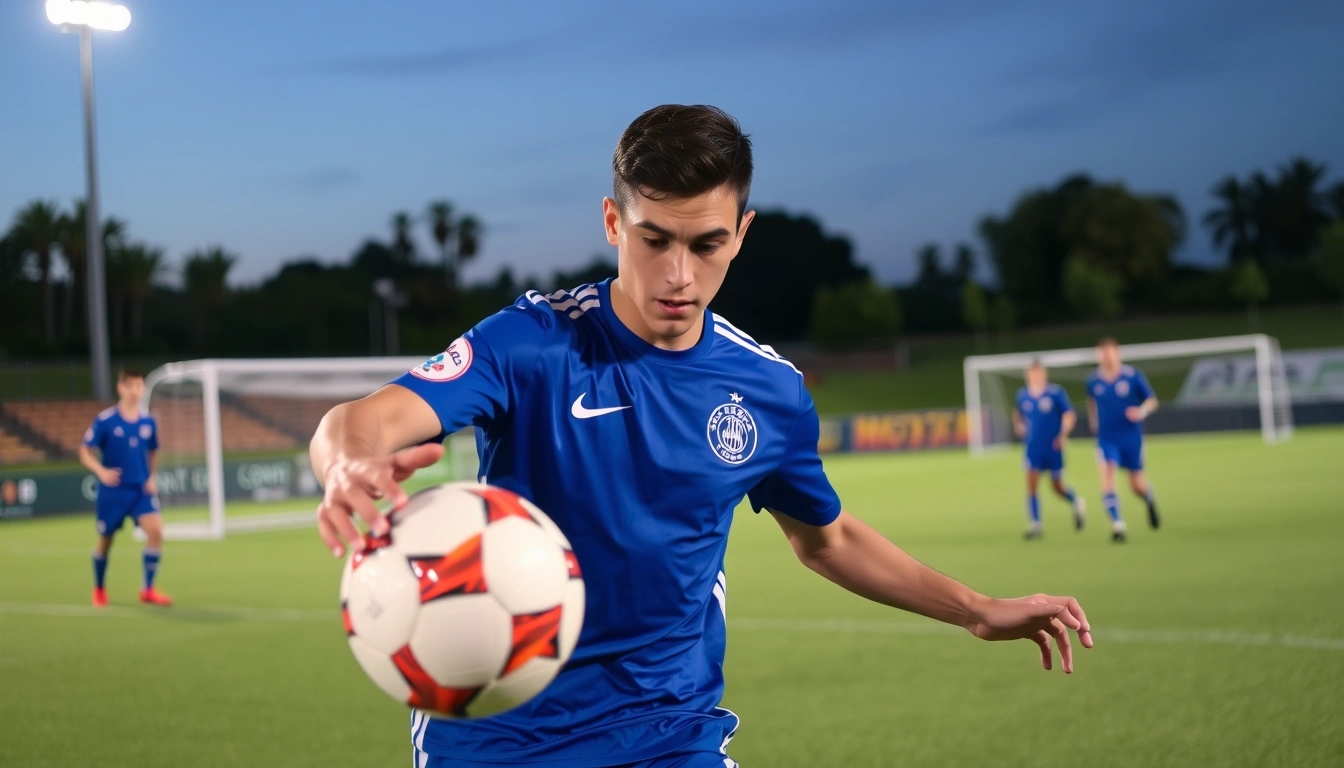Jumping headfirst into the rugged, often thankless world of defensive midfielders, it’s clear this position isn’t for the faint-hearted. If you think it’s all about running around chasing the ball and smashing opponents, well, you’re only half right. Defensive midfielders are like the glue holding the team together, the midfield generals who break up attacks and kickstart their own. For young players itching to boss the midfield, here’s a down-and-dirty guide packed with tips and tricks to help you level up and own that crucial space.
First off, what does a defensive midfielder actually do? Think of yourself as the team’s shield and the spark plug all rolled into one. Your job is to disrupt the other team’s rhythm, snatch the ball cleanly, and then flick it on to your mates in a way that makes the opposition’s heads spin. It’s not glamorous, but it’s essential.
| Core Responsibilities | What It Means |
|---|---|
| Breaking up attacks | Intercept passes, make clean tackles, and force mistakes |
| Starting plays | Quick, smart passes to transition from defense to attack |
| Positioning | Be in the right place at the right time, always |
| Communication | Direct teammates, organize the midfield, and keep everyone alert |
Now, onto the nitty-gritty physical stuff. If you’re not fit as a fiddle, forget about lasting 90 minutes in the thick of the action. Stamina, strength, and agility are your holy trinity. Without those, you’ll be gasping for air and missing tackles like a rookie.
- Stamina: You’ve got to keep running, pressing, and covering ground non-stop.
- Strength: Shield the ball, win physical battles, and hold your ground.
- Agility: Quick feet and sharp turns help you keep up with tricky opponents.
Tackling deserves its own shout-out. It’s an art, not just a smash-fest. Time your tackles perfectly — dive in too early and you’re gifting free kicks and possibly a yellow card. Intercepting passes? That’s where you show your football IQ, reading the game and cutting off threats before they even get started.
Pro tip: Watch the pros and notice how they rarely dive in recklessly. It’s about patience and anticipation, not brute force.
Positioning might just be your secret weapon. The best defensive mids seem to be everywhere and nowhere, always in the right spot to snuff out danger. You want to feel like an invisible wall that attackers just can’t get through.
To wrap it up, here’s a quick checklist for young defensive midfielders aiming to improve:
- Understand your role beyond just tackling.
- Build your stamina, strength, and agility.
- Master the timing of tackles and interceptions.
- Work on smart positioning — be the unseen force.
- Develop passing skills to launch counterattacks.
- Communicate like a boss on the pitch.
- Practice drills that keep it fun but effective.
- Learn from mistakes and keep your cool mentally.
So yeah, it’s a tough gig, but if you put in the work and embrace the chaos, you’ll be the midfield anchor your team desperately needs. Don’t just play the game — own the midfield.
Understanding the Role of a Defensive Midfielder
Alright, so you wanna be a defensive midfielder? Well, buckle up, because this position isn’t all flashy goals and crowd cheers. Nope, it’s the gritty, thankless job of being the midfield’s backbone. Think of yourself as the team’s unsung hero — the one who quietly breaks up attacks, snatches the ball, and kicks off counterattacks without getting much spotlight. Sounds like a lot? It is. But if you pull it off, you’re basically the engine that keeps the whole team running.
Let’s be real: a defensive midfielder’s role is a mix of defense and offense, but mostly defense. You’re the player who sits just in front of the defenders, constantly scanning the field like a hawk. Your job? Stop the opposition before they even get comfy near your goal. That means intercepting passes, making tackles, and cutting off dangerous runs. But it’s not just about smashing into opponents like a bull in a china shop — timing and reading the game are everything here. Jump in too early, and you’re just handing out free kicks or yellow cards. Wait too long, and the attacker’s through on goal. It’s a fine line.
| Key Responsibilities | What It Means |
|---|---|
| Breaking up attacks | Stopping the opponent’s plays before they become dangerous |
| Starting plays | Quickly transitioning from defense to offense with smart passes |
| Positioning | Being in the right place at the right time to intercept or support teammates |
| Communication | Directing teammates and organizing the midfield and defense |
Now, here’s where it gets tricky. You’re not just a destroyer; you’re also a creator. Once you win the ball, you gotta have the vision to spot teammates making runs and the skill to deliver crisp passes that ignite a counterattack. It’s like being a chess player — always thinking a few moves ahead. And hey, if you’re not a natural talker, don’t sweat it. Communication doesn’t mean screaming all game. Sometimes a few sharp gestures or a quick shout is enough to keep everyone on the same page.
- Physical demands: You’ll need stamina to run up and down for 90 minutes, strength to hold your ground, and agility to dodge tricky opponents.
- Mental toughness: It’s a high-pressure role. You’re constantly under the microscope, and one mistake can cost a goal. Staying calm and focused is half the battle.
- Game awareness: You gotta read the flow, anticipate passes, and predict what the opponent’s gonna do next.
So yeah, being a defensive midfielder is no walk in the park. It’s a role that demands grit, brains, and a little bit of swagger. But if you can master it, you become the heartbeat of your team — the player who quietly controls the game and earns respect without always grabbing the headlines. And honestly? That’s pretty cool.
Quick Tips to Remember:- Stay alert and always watch the ball AND your opponent.- Don’t dive into tackles blindly; timing is key.- Use your body smartly to shield the ball and block passing lanes.- Keep your passing simple but effective — no fancy flicks when under pressure.- Talk to your teammates — even a nod counts.
In the end, the defensive midfielder is the unsung hero who keeps the team balanced and ready for whatever the game throws at them. So if you’re ready to put in the hard yards and embrace the chaos, this position might just be your calling.
Key Physical Attributes to Develop
Alright, listen up young midfield maestros! If you want to boss the midfield as a defensive midfielder, you simply can’t ignore the holy trinity of physical traits: stamina, strength, and agility. These three are your best mates when the whistle blows and the chaos of 90 minutes kicks off. Without them, you’re basically a sitting duck waiting to be roasted. So, let’s break down why these traits are absolute must-haves and how you can start building them right now.
First off, stamina is your endurance fuel. Imagine running up and down the pitch, breaking up attacks, and then sprinting forward to launch your own counter. Sounds exhausting? Well, it is! But the secret sauce is to train your body to keep going when everyone else is gasping for air. Trust me, nothing kills your game faster than running out of steam at the 70th minute. So, long-distance running, interval training, and those dreaded beep tests are your friends—even if they make you wanna cry sometimes.
| Physical Attribute | Why It Matters | Training Tips |
|---|---|---|
| Stamina | Keep up with the fast-paced game for the full 90 minutes | Interval runs, endurance drills, cycling |
| Strength | Win physical battles and hold your ground against aggressive opponents | Weight training, bodyweight exercises, resistance drills |
| Agility | Quick turns, dodges, and reacting to sudden changes in play | Ladder drills, cone drills, plyometrics |
Now, onto strength. No, you don’t have to look like a bodybuilder, but having a solid core and strong legs is crucial. Think of it like this: every time you tussle for the ball, a stronger you means you’re more likely to come out on top. Plus, being strong helps prevent injuries and keeps you balanced when the game gets rough and tumble. Squats, lunges, and planks are your go-to moves here, but don’t forget to mix in some upper body work to hold off those pesky strikers.
And finally, agility—the sneaky ninja skill that lets you dart around opponents like they’re standing still. Agility isn’t just about speed; it’s about how quickly you can change direction and react to the unpredictable madness on the pitch. Ladder drills, cone weaves, and plyometric jumps might sound like coach’s torture, but they seriously sharpen your reflexes and footwork. If you can master agility, you’ll be the player everyone fears to face.
- Pro tip: Combine these attributes in your training. For example, do sprint intervals (stamina + agility) or strength circuits with quick footwork drills.
- Don’t forget recovery! Your muscles need time to rebuild or you’ll just end up injured and frustrated.
- Nutrition and hydration are the silent MVPs—fuel your body right to perform at your best.
To wrap it up, developing these physical traits isn’t some magic trick; it’s hard work, sweat, and a little bit of pain. But if you stick with it, you’ll find yourself dominating the midfield, breaking up plays, and setting your team up for glory. So get out there, push your limits, and remember: the midfield is yours for the taking!

Mastering Tackling and Interceptions
Alright, so tackling—yeah, it’s not just about throwing yourself at someone like a wrecking ball and hoping for the best. Believe it or not, it’s actually a skill, an art form if you will. You don’t want to be that guy who’s constantly on the referee’s bad side, right? No one likes a walking foul machine. So, how do you tackle smart and snag those interceptions like a pro? Let’s dive in.
First off, timing is everything. You can’t just dive in like you’re trying to catch the last train home. A good tackle is about patience and reading the opponent. Watch their hips, their eyes, even their breathing if you have to (okay, maybe not literally). When you sense they’re about to make a move or a pass, that’s your moment to pounce. But here’s the kicker—you gotta be clean. If you’re too eager and miss the ball, you’re probably gonna end up on the ground or worse, gifting a free kick.
| Common Tackling Mistakes | How to Fix Them |
|---|---|
| Diving in too early | Stay patient, watch the ball, and wait for the right moment |
| Using too much force | Focus on precision rather than power |
| Not following through | Keep your balance and recover quickly to stay in the play |
Interceptions? Oh, they’re a whole different beast but just as crucial. Think of interceptions like catching a sneaky text from the opposition before they even send it. You gotta be alert, anticipate passes, and position yourself smartly. This means knowing your teammates’ tendencies, the opponent’s style, and the flow of the game. It’s like playing chess but with sweaty jerseys and a ball.
- Stay on your toes: Always be ready to shift your weight and direction.
- Read the play: Watch where the ball is going, not just where it is.
- Communicate: Let your teammates know when you’re cutting off a pass or closing down space.
Now, don’t get me wrong, mastering tackling and interceptions takes time. You’ll mess up—a lot. You might get frustrated, maybe even get a yellow card or two. But hey, that’s part of the learning curve. Keep practicing drills that focus on timing and positioning rather than just brute force. And remember, the best defensive midfielders don’t just break up attacks—they also kick-start their team’s offense with a slick pass right after winning the ball.
Practical Tackling Drill:1. Partner up with a teammate.2. One tries to dribble past while the other times their tackle.3. Focus on getting the ball cleanly, no clumsy lunges.4. Switch roles and repeat.
So next time you’re out there, don’t just go for the big hit. Think, watch, and strike smart. That’s how you become the midfield maestro who bosses the game without racking up fouls. Trust me, your coach and teammates will thank you.
Positioning: The Invisible Advantage
You know, great defensive midfielders are a bit like ninjas on the pitch — they’re everywhere and nowhere at the same time. Sounds like a riddle, right? But that’s the magic of smart positioning. It’s not about sprinting all over the place like a headless chicken; it’s about being in the right spot at the right moment to snuff out danger before it even has a chance to grow. Sounds simple? Well, it’s not. But once you get it, you’re halfway to becoming the midfield maestro your team desperately needs.
Let’s get real for a second: positioning isn’t just standing still and hoping the ball comes your way. Nope, it’s active, it’s dynamic, and it’s downright tricky. You’ve got to read the game like a detective — anticipating passes, predicting runs, and cutting off lanes like a traffic cop on a busy street. It’s about thinking two steps ahead, not just reacting when the attack’s already knocking on your door.
- Stay compact: Don’t leave gaps that attackers can exploit. Your job is to be the wall between the opposition and your defense.
- Angle your body: This helps you block passing lanes and forces opponents into making mistakes or playing backwards.
- Keep an eye on teammates: Position yourself to support defenders and be ready to cover if someone steps out of line.
| Common Positioning Mistakes | How to Fix Them |
|---|---|
| Overcommitting too early | Be patient, wait for the right moment to engage. |
| Getting caught flat-footed | Stay on your toes, keep your knees bent and ready to move. |
| Ignoring off-ball movements | Scan constantly; don’t just watch the ball. |
Now, here’s the kicker — positioning isn’t just about defense. It’s the launchpad for attack. When you’re well-placed, you can snatch the ball and immediately spring a counterattack. Think of it like a chess game: block the opponent’s bishop and suddenly your knight has a free run. That’s the sweet spot where defensive grit meets creative spark.
But hey, don’t expect to nail this overnight. It’s a skill honed through hours of practice, watching games, and yes, making dumb mistakes. You’ll get caught out, you’ll get frustrated, but that’s part of the grind. Keep your head in the game, and remember: the best defensive mids are those who make their positioning look effortless — even if it’s anything but.
Quick Tips for Better Positioning:- Always scan the field every 3-5 seconds.- Anticipate the opponent’s next pass, not just the ball carrier.- Communicate with your defense to maintain shape.- Use your body to shield passing lanes.- Stay patient; don’t dive into tackles prematurely.
So, next time you’re out there battling in midfield, channel your inner ninja. Be the player who’s invisible but indispensable. Because in the chaotic world of soccer, sometimes the best players are the ones you don’t even notice — until they stop you dead in your tracks.
Passing Skills and Vision
Passing Skills and Vision: The Art of Launching Counterattacks
Alright, so you’ve nailed the tough part — breaking up the opponent’s play. But hold your horses, because that’s only half the battle. The real magic happens when you switch gears and spring a counterattack with a slick, well-timed pass that catches everyone off guard. Think of yourself not just as a defensive wall, but as the midfield maestro who sees the pitch like a giant chessboard, always thinking two moves ahead.
Why is vision so crucial? Well, it’s simple. If you’re just smashing tackles and winning the ball but then hoofing it aimlessly upfield, you’re doing your team a disservice. A defensive midfielder with sharp vision spots teammates making runs, notices gaps in the opposition’s shape, and delivers passes that slice through defenses like a hot knife through butter.
- Scan the field constantly: Don’t just stare at the ball. Lift your head up, even when you don’t have possession. This habit helps you spot options early.
- Anticipate movements: Try to predict where your teammates and opponents will be, not where they are right now.
- Keep your passes crisp and purposeful: No one wants a lazy sideways pass that kills momentum.
| Pass Type | When to Use | Key Tips |
|---|---|---|
| Short Pass | Maintaining possession under pressure | Keep it simple and accurate; use the inside of your foot |
| Through Ball | Breaking defensive lines | Time it perfectly to beat offside traps; weight matters! |
| Long Ball | Switching play or quick counters | Look for open spaces and teammates’ runs; use laces for power |
Look, mastering this skill isn’t about being some robotic passer who just hits the safe option every time. Nope, it’s about mixing it up — sometimes you gotta play it safe, other times you gotta thread that risky needle pass that makes your teammates look like stars. And yeah, you’ll mess up sometimes. Passes will get intercepted, and you’ll wonder if you just gifted the other team a goal. But hey, that’s part of learning.
Here’s a little secret: the best defensive mids have this weird sixth sense for spotting opportunities that others miss. It’s not just about raw skill; it’s about game intelligence. You gotta train your brain as hard as your legs. Watch games, replay those moments where a single pass changed the entire match’s momentum. Ask yourself, “Why did that midfielder choose that pass? What was he seeing that I wasn’t?”
- Practice drills: Try passing under pressure with limited touches.
- Play small-sided games: They force quick decisions and improve vision.
- Use video analysis: Study your games to spot missed passing opportunities.
In the end, being a defensive midfielder with killer passing skills means you’re not just stopping attacks — you’re starting them. You’re the engine room, the pivot, the brain behind your team’s rhythm. So next time you win the ball, don’t just breathe a sigh of relief. Look up, think fast, and unleash that perfect pass. Because that’s how legends are made.
Remember: It’s not just about breaking things up; it’s about building something better right after.

Communication and Leadership on the Field
Look, you don’t have to be the loudest voice screaming from the sidelines to be the heartbeat of your team’s midfield. In fact, sometimes the quietest players have the sharpest minds and the best sense of where the game is headed. But here’s the deal — being a defensive midfielder without commanding the flow of the game is like having a fancy car with no steering wheel. You might look good, but you’re not going anywhere fast.
Think of yourself as the midfield general, the one who subtly nudges teammates into position, calls out when to press, and signals when to drop back. It’s not about barking orders all the time; it’s about knowing when to speak up and when to let your actions do the talking. Sometimes a simple shout or a quick gesture can save your team from disaster. Other times, you’ll need to rally the troops when things get messy.
- Use concise, clear commands: “Left,” “Right,” “Man on,” or “Drop back” are simple phrases but pack a punch in chaotic moments.
- Non-verbal cues: Pointing, eye contact, or even a nod can communicate volumes without breaking your focus.
- Stay calm under pressure: If you lose your cool, chances are the rest of the team will too.
| Style | When to Use | Pros | Cons |
|---|---|---|---|
| Direct and Loud | High-pressure situations | Immediate attention, quick reaction | Can annoy teammates if overused |
| Calm and Controlled | Maintaining team shape | Builds trust, reduces panic | Might be ignored in fast breaks |
| Non-Verbal | During noisy moments | Subtle, keeps focus | Not always clear to everyone |
Now, leadership on the field isn’t about being a dictator. It’s more like being a chess player who’s five moves ahead — you gotta anticipate what’s coming, read your teammates’ body language, and adjust your game accordingly. You might spot a defender drifting too far forward or a winger caught sleeping, and your job is to fix that before the other team exploits it.
Here’s a little secret: some of the best midfield leaders aren’t the ones scoring goals or making flashy plays. They’re the ones who make sure the team doesn’t fall apart. So if you find yourself frustrated because you’re not the star player, remember this — your leadership is about making others better. Helping your team stay organized, calm, and ready to pounce is a skill that can’t be learned overnight but is worth every sweat drop.
Practical Tips for Building Leadership Skills:- Watch professional defensive midfielders and note how they communicate.- Practice giving clear, short commands during training.- Work on your confidence to speak up, even if it feels awkward.- Learn to read the game and predict teammates’ movements.- Stay positive and encourage others, especially when the team is down.
At the end of the day, being a defensive midfielder with leadership chops means embracing responsibility without needing a megaphone. Your voice, your vision, and your calm can turn chaos into order. And trust me, your team will notice — even if they don’t say it out loud.
Training Drills Tailored for Youth Players
Alright, let’s get one thing straight: nobody wants to slog through dull, repetitive drills that feel like punishment. Especially young players who’d rather be out there scoring goals or showing off fancy footwork. So, when it comes to training defensive midfielders, the key is to mix fun with effectiveness. You want drills that sharpen skills without turning the session into a snooze fest or a frustration fest. Sounds like a tall order? Well, buckle up, because here’s how you can keep it lively and productive.
- Shadow Tag: This is a brilliant warm-up and positioning drill rolled into one. Pair up players and have one follow the other’s movements closely, mimicking positioning and reactions. The follower tries to “tag” the leader by anticipating moves, while the leader tries to shake them off with quick changes in direction. It’s like a chess game with legs, teaching anticipation and spatial awareness without the boredom.
- Intercept and Pass Relay: Set up a small grid with cones and split players into two teams. One team tries to pass the ball around while the other attempts to intercept and immediately launch a counterattack with a precise pass. This drill hones tackling timing, interception skills, and quick decision-making under pressure. Plus, it’s competitive enough to keep spirits high.
| Drill | Focus Area | Why It Works |
|---|---|---|
| Shadow Tag | Positioning, Anticipation | Develops spatial awareness and quick reactions in a playful way. |
| Intercept and Pass Relay | Tackling, Passing, Vision | Simulates game pressure and encourages smart playmaking. |
| Agility Ladder with Ball Control | Footwork, Agility | Improves quick feet and ball handling, essential for tight midfield battles. |
Now, I know what you’re thinking: “Sure, these sound great, but kids get bored fast!” True, but that’s where the coach’s creativity kicks in. Mix these drills up, throw in some mini-competitions, and reward hustle with small prizes or just good old-fashioned praise. Remember, young players thrive on positive vibes and a bit of challenge — not endless repetition.
Here’s a quick list of tips to keep these drills fresh and effective:
- Keep sessions short but intense — 15 to 20 minutes per drill max.
- Rotate players through different roles to build versatility.
- Use music or countdown timers to add urgency and excitement.
- Encourage players to communicate during drills — it builds leadership early.
Finally, don’t forget the mental side. Throw in scenarios where players have to make split-second decisions or adapt to unexpected changes. It’s not just about muscle memory; it’s about developing soccer IQ. Because at the end of the day, a defensive midfielder who’s sharp in the head and quick on their feet is worth their weight in gold.
So, there you have it — no dull drills, just smart, engaging exercises designed to turn young defensive midfielders into midfield maestros. Keep it fun, keep it real, and watch those skills soar.
Common Mistakes and How to Avoid Them
Alright, let’s be real — every young defensive midfielder has been there, fumbling around like a cat on a hot tin roof. It’s part of the learning curve, but if you keep falling into the same traps, well, you might as well hand the ball to the other team and take a coffee break. The good news? Knowing the typical screw-ups can save your bacon and maybe even earn you some street cred on the pitch.
- Diving in too early: This one’s a classic rookie blunder. You see the ball heading your way and you just *have* to make that tackle NOW. Spoiler alert: patience is a virtue. Jumping in prematurely often means you miss the ball completely or get skinned by a quick feint. Instead, try to read the attacker’s body language and wait for the perfect moment to pounce. Timing is everything.
- Poor positioning: Defensive midfielders aren’t just there to run around like headless chickens. If you’re out of position, you’re basically handing the opposition the midfield on a silver platter. Stay central, anticipate passes, and keep an eye on both the ball and your teammates. Think of yourself as the team’s invisible wall – tough to get through if you’re in the right spot.
- Overcommitting to tackles: Going all-in every time might make you look fearless, but it’s a double-edged sword. You risk fouling, giving away dangerous free kicks, or worse, getting booked. Sometimes, the best move is to contain and delay the attacker, allowing your defenders to regroup.
- Ignoring communication: You don’t have to be the loudest on the pitch, but a little chatter goes a long way. Let your teammates know when you’re closing down or need support. A well-timed shout can prevent a lot of chaos.
| Mistake | Why It Happens | How to Fix It |
|---|---|---|
| Diving in too early | Impatience, eagerness to win the ball | Practice patience, focus on timing tackles |
| Poor positioning | Lack of game awareness | Study game flow, watch pros, stay central |
| Overcommitting | Overconfidence, fear of losing ball | Learn to contain and delay attackers |
| Ignoring communication | Shyness, lack of confidence | Develop simple signals and calls |
Now, here’s a little nugget for you: mistakes aren’t just screw-ups, they’re learning opportunities disguised as bruises on your ego. So next time you find yourself lunging at shadows or yelling at the wrong teammate, take a breath, laugh it off, and think about what you could do differently.
Tip for Practice:- Set up small-sided games focusing on positioning.- Use video clips to analyze your movement.- Work on communication drills with your team.
Remember, defensive midfield is a tough gig. You’re the engine, the shield, and sometimes the unsung hero. But if you keep these common pitfalls in check, you’ll be the one making the opposition sweat — not the other way around.
Keep grinding, stay sharp, and don’t be afraid to mess up. That’s how champs are made.

Building Mental Toughness and Game Awareness
Soccer is often seen as a physical sport — sprinting, tackling, jumping, and all that jazz. But let me tell you, the real battle happens up here (points to head). Mental toughness and game awareness? Those are the secret weapons of any great defensive midfielder. If you think muscle alone will get you through, well, you’re in for a rude awakening. It’s like trying to win a chess game by only moving your pawns forward — you gotta think, anticipate, and stay cool when things get wild.
First off, staying calm under pressure is easier said than done, especially when the crowd is roaring, the scoreboard’s tight, and your legs feel like jelly. But here’s a nugget for you: breathing matters. Sounds basic, right? But deep, controlled breaths can keep your brain from short-circuiting when the opposing team is breathing down your neck. Practice this off the field — maybe when you’re stuck in traffic or waiting in line for that extra-large soda. It’s weirdly helpful.
| Tip | Why It Helps | How to Practice |
|---|---|---|
| Controlled Breathing | Reduces anxiety and sharpens focus | Try 4-4-4 breathing: inhale 4 seconds, hold 4, exhale 4 |
| Visualization | Prepares your mind for game scenarios | Imagine intercepting passes or making perfect tackles before games |
| Mindfulness | Keeps you present and aware | Spend 5 minutes daily focusing on your senses and surroundings |
Now, about reading the game — it’s like having a sixth sense. You want to predict where the ball’s going before it even leaves an opponent’s boot. This comes with experience, but also paying attention to patterns. Watch how players move, their body language, even the tiniest twitch can give away their next move. It’s not just luck; it’s about training your brain to connect the dots faster than the other guy.
- Watch and Learn: Spend time watching professional matches focusing on midfielders’ positioning and decisions.
- Ask Questions: After games or training, discuss what you saw and why certain plays worked or failed.
- Play Small-Sided Games: These tighten the space and speed up decision-making.
And hey, don’t beat yourself up when you mess up. Mental toughness isn’t about being perfect; it’s about bouncing back. Next time you lose the ball or miss a tackle, shrug it off, learn, and get back in the game. It’s like life — you can’t control everything, but you can control how you respond.
Remember:- Stay calm, breathe deep.- Train your mind as hard as your body.- Read the game, don’t just react.- Learn from mistakes, don’t fear them.
So, if you want to own the midfield, start thinking like a pro. Your brain is your best teammate — don’t leave it on the bench. Master the mental game, and the physical stuff will fall into place.
Frequently Asked Questions (The title must be written in English.)
- What makes a good defensive midfielder stand out?
Great defensive midfielders are like the midfield’s secret weapon – they break up attacks, control the tempo, and start counterattacks with pinpoint passes. It’s not just about physicality; it’s about reading the game like a chess master and positioning yourself where the action is about to explode.
- How can young players improve their tackling without fouling?
Tackling is an art, not a brawl. Timing is everything. Instead of lunging in recklessly, focus on anticipating the opponent’s move and intercepting passes. Practice drills that sharpen your reaction and body control to avoid becoming the team’s walking foul machine.
- Why is positioning so important for a defensive midfielder?
Think of positioning as your invisible armor. Being in the right spot at the right time lets you cut off attacks before they even start. It’s like setting traps on the field, making you look everywhere and nowhere at once – confusing opponents and protecting your defense.
- What physical attributes should I focus on developing?
Stamina, strength, and agility are your holy trinity. You need to endure the full 90 minutes, win physical battles, and move swiftly between defense and attack. Training these will keep you sharp and ready for the chaos midfielders face every game.
- How important is communication as a defensive midfielder?
Communication is your secret weapon to lead without shouting. Coordinating with teammates, calling out threats, and directing play can turn you into the midfield general your team desperately needs. It’s about being heard and understood, even in the heat of battle.
- Can mental toughness really impact my performance?
Absolutely! Soccer is as much a mental game as a physical one. Staying calm under pressure, reading the flow of the game, and bouncing back from mistakes will give you an edge that’s as explosive as any physical skill.
- What are some common mistakes young defensive midfielders make?
Diving in too early, poor positioning, and trying to do too much alone are classic rookie errors. Recognizing these traps early helps you avoid costly mistakes and keeps you playing smart, not just hard.
- Are there fun drills that help improve defensive skills?
Yes! Drills that mix competition with skill-building keep training exciting. Think small-sided games, interception challenges, and agility courses that feel more like play than work – perfect for keeping young players motivated.










